Utrecht’s tiny Koekoekstraat (Cuckoo Street) is one of many places that has been transformed recently to give cycling more space. Yet another example that the city of Utrecht is serious in making the city better for people and declaring the bicycle to be the city’s most important type of transport wasn’t some hollow phrase.

I’ve said it before: “Utrecht is changing rapidly” and indeed so fast that I can barely keep up. This reconstructed street was already opened last summer, but I had so many other things to tell you that I can only now show you what has been done here. This is one of the smaller streets of the city’s reconstruction project. I’ve shown you very big transformations, such as the returned city moat and the upgrading of the former city ring road at ʼt Goylaan, mid-sized projects such as Maliesingel, Adriaen van Ostadelaan and Mariaplaats, and the much smaller streets of Domstraat and Twijnstraat. The Koekoekstraat, however, is a truly tiny street. At the beginning of the street the full width is only 7 metres (or just short of 23 Feet), while the second part of the street is exactly double that width: 14 metres. How are you going to make a street that narrow better for people without banning motor traffic? The only answer was to make it a cycle street and that is exactly what the city of Utrecht proposed to the residents.

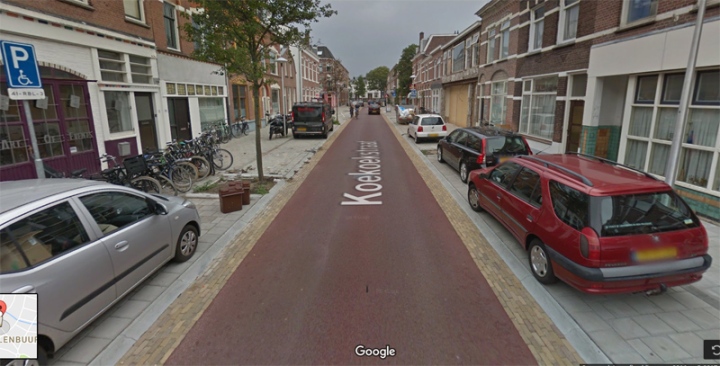
Koekoekstraat used to be a through street with a lot of shops, but that was decades ago. Now it has become a residential street. You now mostly see living room curtains behind the former shop windows. The tiny street had a one-way system, also for cycling, and serves as one of the very few motor traffic exits out of the city centre. That meant the motor traffic volume could not really be reduced, but something had to be done.
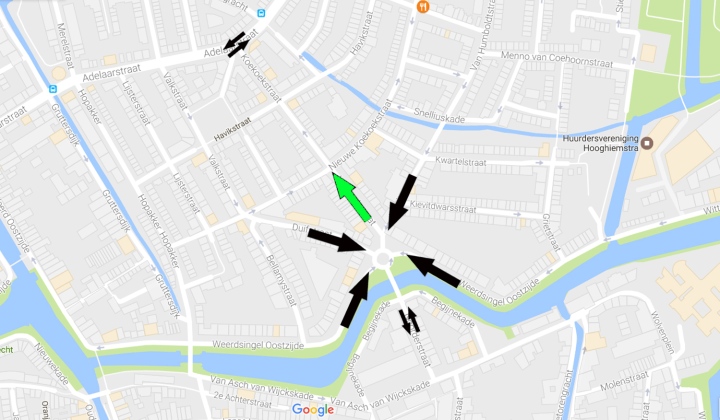
The city motivated the need for change as follows:
- the one-way system encourages speeding;
- people cycling are inclined to ride against traffic;
- the street feels busy and unsafe.
To increase traffic safety (especially for cycling) and to make the street more liveable, the city proposed to make the street a cycle street, with the following (additional) measures:
- cycling will get more space, cars will be guest;
- cycling will become allowed in two-directions;
- the street will be paved with smooth brownish-red asphalt;
- the asphalt strip will be 3.5 metres wide;
- car parking will be on the same level as the sidewalk;
- the number of car parking spaces will remain the same;
- there will only be parallel parking to optically narrow the street;
- the number of bicycle parking spaces will be increased;
- lighting will be improved if necessary.
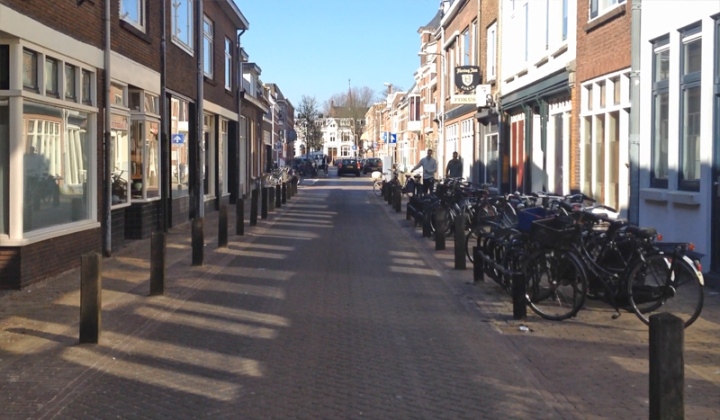

In 2015, the city planned several community meetings, where residents and other stake holders got the opportunity to say something about the plans. But the decision that the street would become a cycle street was already taken. Expectations about the residents’ influence were further tempered by how the reconstruction was framed.
- The traffic management in the area (traffic flows) and the direction of the one-way street cannot be changed.
- Decreasing the (motor)traffic volume falls outside the scope of the project.
The city could be pleased, however, that – by and large – the residents were in favour of making the street a cycle street. The city then proposed some smaller and larger details that the residents could decide about. This included the location of trees in the wider part of the street, planters in the narrower part and possible “images” on the surface.
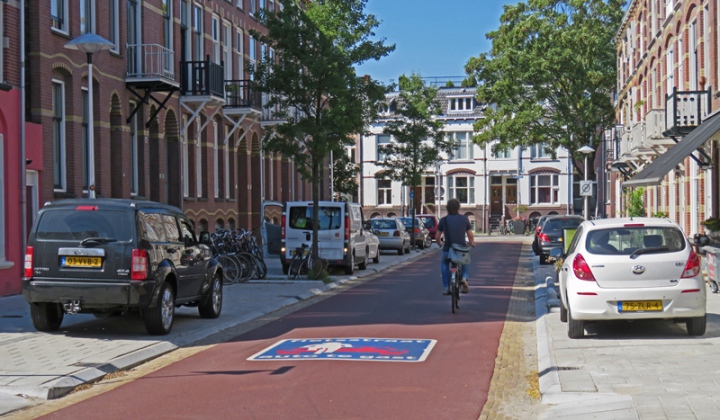
The minutes of the community meetings give an almost amusing insight into the evenings.
“The city representative informs that the narrower part of the street will get some planters. That part of the street is too narrow for trees. When planters are placed, residents must take care of their maintenance. That is not the case for the trees. ‘When there are people who do not want a planter in front of their home, they can be moved elsewhere’. The resident of house number 25 makes clear that he does not care for a planter in front of his house. ‘It will be a dirt collector, beer cans, cigarette butts and so on.’ He can live with it if a neighbour wants one. Another resident mentions that the smaller size of the planters will prevent that from happening. But the first resident insists that won’t make any difference: there will be cans and cigarettes. The city representative proposes to place the planter in front of house number 27 [right next door]. But the resident of number 25 doesn’t want any planters near his home.”
In the end (possibly because of this discussion) the number of planters was reduced in favour of extra bicycle parking. The street also got something special: images on the surface, at the request of the residents. The discussions about these images were quite elaborate and again somewhat amusing:
“The city representative says that the city is not against images on the road surface to emphasise the street’s safety, but experts doubt if it helps. Even so, such images on the asphalt can indeed be created. The material used is thermoplastic. That may, however, become somewhat slippery in wet weather. In addition, related to the material, the image cannot have too much detail. If images were to be placed they must be placed in the middle of the road. People cycling will otherwise navigate around them and there may also be some noise when cars drive over them. A resident says that the images were an idea to break the length of the street and at the same time they would influence the speed of car traffic. Another resident is a proponent of images; it will decrease the speeds. Yet another resident is also for a picture, but feels it must have something to do with the neighbourhood. The city representative promises to look into possible images. Maybe of children? One must bear in mind that the images must be of a fairly coarse design related to the material and maintenance. In addition to images, lines were also considered. Most of the residents are for images, despite possible objections like that they will become slippery in rain. A resident has an idea for the image. The word “Bicycle Street”, including the icon of a bicycle and below that the text “cars are guest”. The traffic expert notes that signs with such a text and image could work very well. They aren’t official traffic signs, but this is used more often on roads in the municipality. He shows an example. The image is a standard image, because the city wants to use the same symbols and signs throughout the city, to improve their recognisability. The residents understand that. It is repeated that the image on the road cannot be too detailed, but the city will consider the request. According to the residents who are present three large images on the road surface should be enough. Traffic users won’t be able to miss them. The city representative asks the crowd if it should be an image such as one of the residents has just suggested or maybe of a cuckoo? Unanimously the residents are of the opinion that the image of a bicycle would be better to emphasize that the street is a cycle street. The traffic expert notes that the image may not give the impression that the street is a cycle path, cars are allowed. Some of the residents can live with the standard traffic sign used for a cycle street. The city representative inquires if there are any other ideas now that there still is room for discussion. But the residents in the room want to decide at that moment. The city representative establishes that a majority of the attendees is in favour of the standard road sign for a cycle street and that the cuckoo is off. The standard image of the bicycle street where cars are guest is recognisable and already used in more parts of the city. This image can therefore not lead to confusion. The residents who are present in the hall agree.”
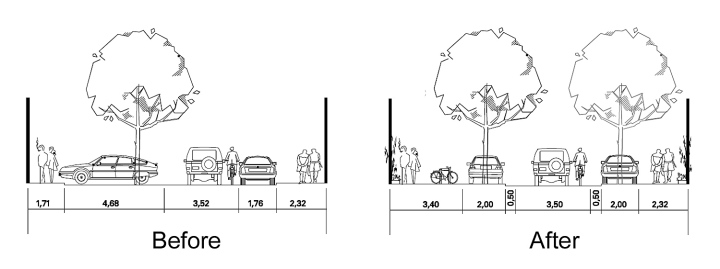
The reconstruction of the street was finished in the summer of 2016. Afterwards, the city of Utrecht has investigated how the street functions. It turned out that a large number of motorists drove too fast. Additional speed decreasing measures were therefore considered, but it was decided that a bit more time should be taken to let people get used to the decreased speed limit of 30km/h (was 50km/h). The residents generally like the new look of the street and one told a local news site that he was happy with the change of the street, that had been discussed for many years: “At last something changed! There is still too much motor traffic, which is also too noisy, but this is a start. In the near future, when there really is much less car traffic in the city centre, this cycle street will surely become a true cycle path. I would gladly welcome the expected ‘at least 3,000 cyclists a day’ in my street.”
A before and after comparison in this week’s video.


If it was up to me I would have had each street lamp look like a cuckoo clock.
Or even a bird holding a lantern in the beak.
There are now much less bicycle stands than before. And indeed the car speed / volume still is too high for a cycle street.
Actually the official number of bicycle parking spaces increased. There were 88 parking spaces before and 122 spaces after the reconstruction. And those are racks that bikes lean against, (“nietjes”) about which the residents commented they will be used for 4 bikes instead of the normal 2. So the actual number of parked bikes will be much higher. (From the Presentation)
Informative post, as always Mark!
I’m interested by comments about ‘motor traffic’, particularly from residents about there being ‘too much’ of it. Clearly this is a relatively important road out of the city centre, with no alternative, but from your videos it doesn’t appear to be *that* busy – at least, from a British perspective. Do you have any idea what daily flows of motor vehicles actually amount to? Thanks.
The motor traffic volume is now 3,000 vehicles per (working) day. That would mean there should be 6,000 cyclists to make it a 2:1 ratio and that is not the case. There aren’t that many people cycling here. So this is stretching the recommendations in the hope that the car volume will go down due to the design to make the ratio right in future. In the Dutch context 3,000 mv/d is considered busy.
Check Instagram Koekoekstraat_Fietsstraat for the actual situation 2020. Still 3000 mv/d and nowhere near the amount of 6000 cyclist. I say about 1000 per day. Cars practice their skills here like Max Verstappen.
I should imagine the same as in the UK: cars are parked all over our footways (except perhaps in London). Surely expecting cars to be on the footway because so many of them are parking illegally is no different to expecting cars to be on part of the footway because the arrangement has been formalised.
Cycling Dutch: It looked like cyclists shared the roundabout with traffic. Can we have a few more shots of that, please?
Cars are not parked on the footway. There is a separate footway that always stays clear of parked cars as Jan also explained. But the designated car parking is on the same level as the footway and also with the same surface. That means that when no car is parked there, that space does not look like empty roadway, but rather like extra footway.
The roundabout is shared yes, but you cannot see that in the video. (The video begins already outside the roundabout.) A shared space roundabout is unusual and should not be copied. Can only work here due to low speeds and relatively low traffic volumes. See streetview.
How is a blind person expected to know where to walk if the car parking space doubles as pedestrians space when no cars happen to be parked?
There’s a continuous ‘walking space’ close to the houses, and a ‘mixed area’ with either planters, bicycle parking or car parking. Doesn’t look that confusing to me, and is very common in the Netherlands. For a residential street, the layout here is quite predictable. In shopping streets, you’ll often find signs and other obstructions on the sidewalk, which are far more annoying to the visually impaired.